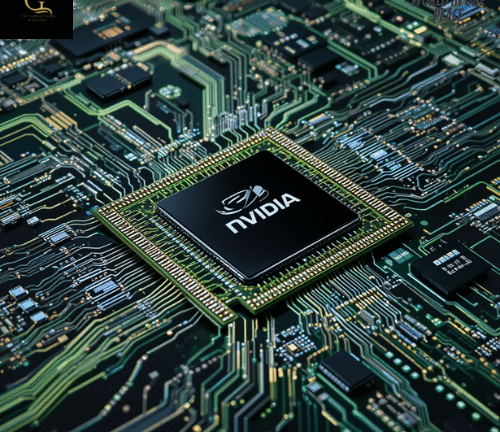Nvidia’s $4.5 billion China chip dump: An expensive geopolitical lesson
The unchallenged leader in the production of AI chips, Nvidia, has encountered an unforeseen and costly obstacle. Due to increasingly tightening U.S. export rules, the business was compelled to write off $4.5 billion worth of chips that were initially intended for China. These weren’t just any chips, either; they were “H20” variants that were specifically intended to skirt regulatory red lines in the United States. The risk? It was unsuccessful.
Let’s examine what transpired, why it matters, and what it indicates about the condition of the AI hardware industry both now and in the future.
A Sanctions-Related Issue
Over the past two years, the U.S. government has tightened export regulations in an effort to limit China’s capacity to create advanced military and artificial intelligence applications. Rules prohibiting the export of high-performance chips, such as Nvidia’s A100 and H100 models, were put into place by the Biden administration.
Nvidia created new chips such as the A800, L20, L2, and H20 in order to sustain its profitable China business, which is thought to account for 20% of its data centre income. To remain inside the bounds of what was permissible for export under U.S. regulations, these models purposefully had restricted capabilities.
However, the regulations were altered once more.
Even those little windows were blocked in early 2024 by additional export restrictions. Despite being legally compliant when they were designed, Nvidia’s H20 chips were no longer permitted for shipment. Due to their compromised capabilities, the corporation was left storing merchandise that was not only illegal to export to China but also prohibited from being resold elsewhere.
Why the H20 Chips Didn’t Work
Nvidia’s best chance of regaining some business from China was the H20. However, Chinese consumers were dubious even prior to the most recent export prohibition. Despite being legally permissible, these chips were deemed too diluted. Performance is a must for data centre operators and AI companies creating robust models.
As a result, Nvidia has no market and a mound of unsold, underpowered processors. CEO Jensen Huang acknowledged on the business’s results call that the unused inventory was costing the company billions of dollars. Huang stated unequivocally that these chips “cannot be sold or repurposed,” according to Fortune.
It’s a harsh illustration of how policy can supplant product so swiftly.
Business Shockwaves
Not only is the write-off substantial in terms of money, but it also highlights how flimsy region-specific innovation strategies are in a rapidly shifting geopolitical landscape. In order to be competitive in the Chinese market, Nvidia had to modify its product specifications to comply with US regulations. However, the rules were too swift.
Others in the semiconductor sector have received a clear message from this: a product cannot be future-proofed against geopolitical upheaval. “Today’s legal workaround may be tomorrow’s banned product,” one analyst stated.
Investors have also paid attention. Even if Nvidia is still leading the AI race, any doubt over China’s revenue share raises concerns.
Positive Aspects in a Competitive Industry
Ironically, Nvidia shows strength in other areas while absorbing this loss. The reputable AI benchmarking organisation MLCommons claims that Nvidia’s new Blackwell chips can train huge AI models more quickly than the Hopper chips of the previous generation by a factor of more than two. That’s a huge jump that demonstrates how quickly Nvidia is still evolving.
Nvidia’s continued dominance in the high-end training market is demonstrated by the fact that it was the only firm to submit performance statistics for training Meta’s large open-source model Llama 3.1 405B. This is particularly crucial because one of the most resource-intensive and lucrative areas of AI computing is still training AI models.
Even if AI inference—the way AI models assist users in real time—may be the stock market’s current focus, the hardware and software needed to train those models are still crucial. Here, Nvidia remains king.
China’s Reaction and the Overall Situation
Chinese businesses like DeepSeek and Huawei are trying to fill the gap in the meantime. Recently, DeepSeek asserted that it could train competitive AI models with significantly less processors than its American competitors. However, as of right present, no Chinese company can truly compete with companies like Hopper or Blackwell.
The more general lesson? This setback for Nvidia is a sign of a larger systemic problem. National policy, semiconductor production, and AI are now more intertwined than ever. Each chip serves as a bargaining chip, a strategic asset, and possibly a diplomatic flashpoint in addition to being a piece of hardware.
Concluding remarks
The $4.5 billion chip dump from Nvidia in China is more than simply a business issue. It serves as a warning to the whole tech sector about the dangers of using geopolitically sensitive product strategies. When politics takes precedence over innovation, even industry titans like Nvidia may find themselves in the crossfire.
The business still has an unrivalled technological advantage, though. Its ongoing success in pushing the limits of AI hardware, such as with Blackwell, demonstrates that, despite possible political danger, it is still essential to the AI revolution.
Additionally, businesses will want stronger geopolitical foresight in addition to better semiconductors in the future.




